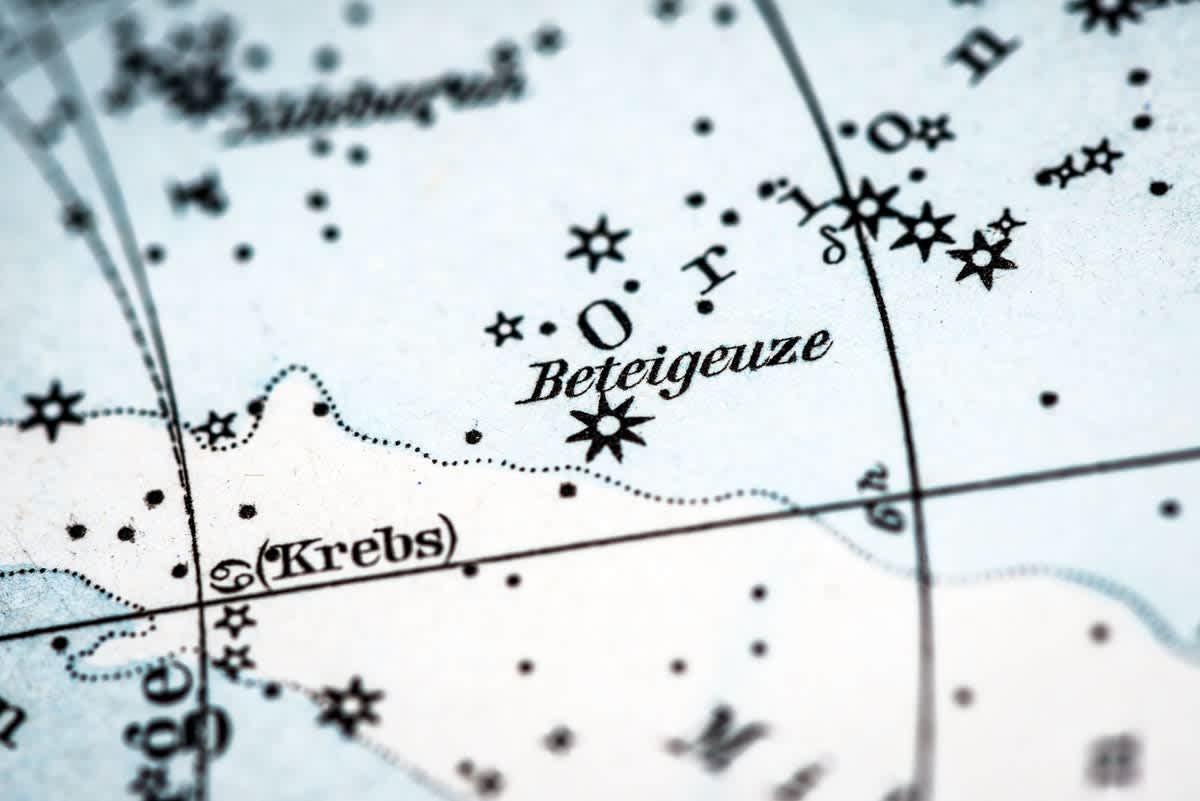What’s in a (Star’s) Name?
With billions of stars in the Milky Way, some nomenclature standardization is necessary
A close-up photograph of the star Betelgeuse as it appears in an antique German sky atlas.
Stay connected to The Universe: Get email alerts for this weekly column by Phil Plait
Betelgeuse! Betelgeuse! Betelgeuse!
Did it explode? No? Okay, then.
But it seems fair to ask: Why “Betelgeuse”? It’s an odd-seeming name for a star. That’s because it’s a corrupted translation of the Arabic phrase yad al-jawzā’, which roughly translates to “the hand of Orion”—a decent moniker for the star that does represent the constellation’s upraised arm.
If you’re enjoying this article, consider supporting our award-winning journalism by subscribing. By purchasing a subscription you are helping to ensure the future of impactful stories about the discoveries and ideas shaping our world today.
A lot of star names we use today are in fact Arabic in origin; the Alexandrian astronomer Claudius Ptolemy created a star map of the sky for his wildly popular book Mathematical Treatise, written in Greek around C.E. 150. It was translated into Arabic more than 1,000 years ago and acquired a nickname, Almagest—itself a corruption of the Arabized version of the Greek word for “the greatest”—and many of those Arabic versions of star names were kept even when the map was translated into different languages. Rigel, Deneb Aldebaran, and many more of the brightest stars in the sky trace their names back to such quirks of ancient publishing.
You might think we’d run out of names quickly, too, because there are many thousands of stars visible to the unaided eye at night. Fewer than 1,000 stars have proper names, however, so that doesn’t seem like a crisis—which is a good thing because there are hundreds of billions of stars in the Milky Way! So the problem isn’t naming them so much as naming them consistently.
Different ancient cultures had their own names for stars, but as the world became more interconnected astronomers tried many systems to standardize names and naming, with varying degrees of success.
One of the first in the modern era, published in 1603, was dreamed up by the German astronomer Johann Bayer. He named each star according to its apparent brightness ranking in a given constellation, using a Greek letter and the genitive (possessive) case of its constellation name. So for example, the brightest star in Orion would be called Alpha Orionis, the next brightest Beta Orionis, and so on. There are two problems with this system, however. First, the Greek alphabet is only 24 letters, so that limits the names you can use this way. Second, stars can change brightness over time, wreaking havoc on the ordering of a constellation’s star names.
About a century later the English astronomer John Flamsteed came up with the idea of using numbers instead of letters, which obviates one of Bayer’s problems. Also, instead of using stars’ sometimes-varying brightness, he designated them by their position in a constellation, starting with the western edge of the constellation and moving east. So for example, 1 Orionis is not the brightest star in Orion but the one closest to its western edge.
This has problems, too. Constellation borders weren’t officially defined until the International Astronomical Union approved them in 1928, so Flamsteed’s catalog occasionally listed stars as being in one constellation when they were actually in another. Also, Flamsteed only catalogued stars he could see from England, which excludes a large part of the southern sky that’s invisible from that latitude.
When the Hubble Space Telescope was being built, astronomers realized that to properly point it they needed a very accurate list of star positions and brightnesses, so was created, which currently includes nearly a billion stars. These are observed by special sensors on Hubble that then use the known positions of the stars to navigate where the telescope needs to be aimed.
Anyway, an unavoidable problem here is that any given star can have a lot of names, even sticking to the legitimate ones. A lot. Our old friend Betelgeuse, for example, has no fewer than 46 designations listed at SIMBAD, a database of astronomical objects beyond the solar system. Sure, in that case everyone just calls it “Betelgeuse,” because that’s its recognized name (and it’s fun to say), but for other stars the name used can depend on which astronomer is observing it, and how it’s being observed. A star might have been discovered in an infrared astronomical survey, but also independently in a radio-wave observation, so different astronomers will call it different names depending on what part of the spectrum they’re most familiar with.
But I’m okay with this; it gives us a certain flexibility with naming, and it’s not hard to look up which names go with what star.
And of course, in the end, a star by any other name would shine as sweet.
Phil Plait is a professional astronomer and science communicator in Virginia. His column for Scientific American, The Universe, covers all things space. He writes the Bad Astronomy Newsletter. Follow him online.
Source: www.scientificamerican.com
